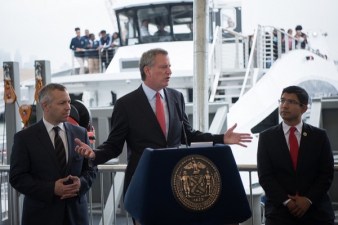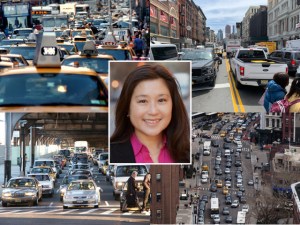Details of Sam Schwartz’s “Fair Plan” and Other Orcutt+Komanoff Highlights
NYU students got a sweeping overview of NYC transpo and traffic issues from two of the city’s top thinkers this afternoon, as DOT Policy Director Jon Orcutt and independent analyst/congestion pricing advocate Charles Komanoff took turns on the mic at a forum moderated by NYU Law School professor Roderick Hills. I got so caught up in the moment that I completely forgot to snap a photo of Orcutt and Komanoff sharing the stage.

With the MTA budget all over the headlines and “Gridlock” Sam Schwartz’s plan to rationalize NYC bridge tolls nabbing a full-throated endorsement from former Times editor-in-chief Bill Keller, the juiciest info to come out of the forum were the road pricing plans that Komanoff outlined. He went over the basics of the current Sam Schwartz plan and his own “Move NY” package, both of which now mix fees on driving into the Manhattan CBD with toll discounts on crossings in the other boroughs.
Each plan promises to fund the region’s transit system while curbing traffic on city streets that see the heaviest pounding from motor vehicles. First up, the basics of Gridlock Sam’s “Fair Plan,” as presented by Komanoff:
- $5 E-ZPass or $7.50 cash fee each way for motorists crossing the Manhattan CBD cordon (assessed at the East River crossings and 60th Street).
- An average 39 percent toll reduction on the seven MTA bridges that don’t enter the CBD (i.e. the Verrazano, Whitestone, Throgs Neck, Triborough, Henry Hudson, Cross Bay, and Marine Parkway bridges).
- Truck tolls would be 2.2 times higher than private car tolls.
- A $1.00 “drop fee” assessed on each cab trip.
- About one percent of vehicles would be exempt from tolls (not clear how the exemption would be determined).
- In addition to funding transit with its projected $1.2 billion in net annual revenues, the Fair Plan would set aside funds for regional highway investments and three new bike-ped bridges into Manhattan — one over the Hudson, one from Long Island City, and one from the Brooklyn waterfront that would connect to the Battery via Governors Island.
You can see how Komanoff calculates the benefits of the Gridlock Sam plan in his Balanced Transportation Analyzer spreadsheet.
Komanoff’s Move NY Plan, which is being advanced by the campaign that grew out of Ted Kheel’s advocacy for road pricing combined with lower transit fares, has a time-variable tolling structure, like the 2008 congestion pricing plan. You can also look up the projected benefits and costs in Komanoff’s spreadsheet. It features:
- Fees to drive into the Manhattan CBD that range between $3 during the least congested times of day and $9 during the most congested times. There is no outbound fee.
- A 15 percent toll reduction on the seven non-CBD MTA bridges.
- CBD fees are waived for the first trip a vehicle makes each month.
- Surcharges on yellow taxi trips — 12 percent for miles, 20 percent for waiting, and a 25-cent drop fee.
- Truck tolls averaging 1.6 times private auto tolls.
- Express bus fares reduced by 10 percent.
- Commuter rail trips that begin and end inside NYC would cost the same as a subway fare.
Last but not least, a few interesting nuggets came out of Orcutt’s presentation that Streetsblog readers may not have known. Among them: The DOT’s plaza projects, which so far have been built with low-cost materials, have all been added to the capital project pipeline. So the day will come when those plazas will look nicer and sturdier, like part of the permanent streetscape. DOT hopes to break ground on the permanent version of the Times Square plazas next year.

